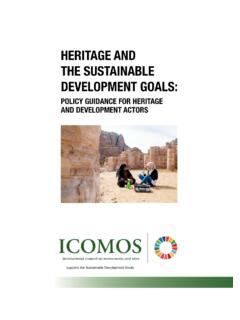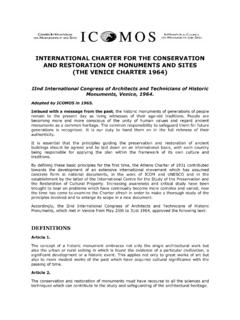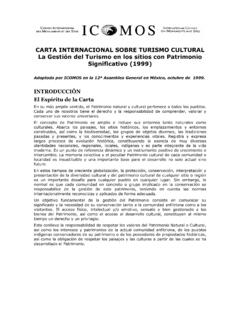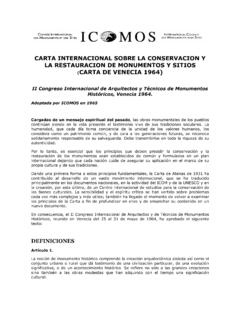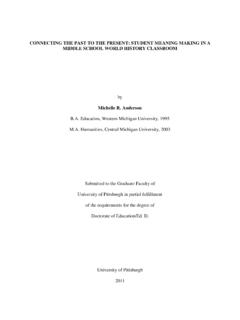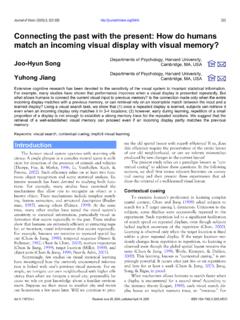Transcription of BASILICA NOVA: CONNECTING ARCHITECTURE PAST AND …
1 267 Estrategias relativas al Patrimonio Cultural Mundial. La Salvaguarda en un Mundo Globalizado: Principios, Pr cticas y PerspectivasStrategies for the World s Cultural Heritage. Preservation in a globalised world: principles, practices and perspectivesStrat gies pour le Patrimoine culturel du monde. La conservation, dans un monde globalis : principes, pratiques, perspectivesBASILICA NOVA: CONNECTING ARCHITECTURE past ANDPRESENTM ichele Chiuini *IntroductionFor many years our school of ARCHITECTURE has offered asummer course in Italy including a design studio for studentsof ARCHITECTURE , planning , and landscape ARCHITECTURE . Thefocus of the studies has been preservation in historic centersand the reuse of abandoned sites. Each year a different Italiancity has hosted the design studio and set a theme for theproject, dealing not only with reuse of historic buildings, butalso with abandoned industrial sites, and reconstructions ofparts of the historic city.
2 The question of conservation ofhistoric centers has in this way been approached as anarchitectural problem, addressing new development inaddition to conservation of the existing. Examples of theseprojects are the work on the Papigno area for the city ofTerni, and on the Canapina area within the historic walls ofPerugia. (Fig. 1 Papigno, Terni. Industrial area seen from thehistoric center of Papigno. Fig. 2 Perugia, Canapina project)In 2001 the program received the collaboration of theSuperintendence for Archeology of Rome, which has allowedundertaking a study of two major monuments: the BASILICA ofMaxentius, and the Baths of Diocletian. The questions raisedby these students projects are the dialectics between thecity and archeology, the intelligibility of the ruins, and thepublic uses of these sites. The program for the BASILICA ofMaxentius in the Forum was provocatively requiring areconstruction of the BASILICA as a usable space.
3 This forcedthe students to look critically at authenticity and values inthe light of recent examples of reconstruction of ruins, use ofancient monuments, and protection of archeological is built on the past , metaphorically and only knowledge comes from the experience of buildingand the understanding of traditions: cities in Europe areliterally built over older structures and along ancient roads(Fig. 3. Housing in the historic center of Lucca, built over theRoman amphitheatre). Archeological sites have becomemajor tourist attractions but, at the same time, have frozenthe historic architectural transformation process consequentto urban growth. The reconstruction of the BASILICA positsthe question of how reconstruction and reuse canpreserve an archeological site and reintegrate it intourban life. It is essentially a critical analysis of currentprinciples of conservation, and also a reflection on the impactthat such monuments have had and continue to have on thearchitecture of the architectural lessonsThe BASILICA (Fig.)
4 4 BASILICA of Maxentius as it stands todayin the Roman Forum) is a very large building, even by today sstandard, measuring about 65 m. x 100 m. The BASILICA wasstarted by Maxentius, and was called at his time BasilicaNova, or new BASILICA . We have purposely used this namein the program for its reconstruction, as it would be in fact,again, a new BASILICA . We refer to the original construction asthe BASILICA of Constantine, after the emperor who completedand remodeled it in the 4th century. This emperor is alsoresponsible for major transformations in the Roman world:the legalization of Christianity, and the replacement of Romewith the new capital of Constantinople. In architectural terms,this is symbolic of the translation of the Roman BASILICA intoa religious building type that continued to evolve from lateRoman through medieval and modern Europe. What are themost important lessons to learn from the BASILICA ? Much couldbe said about the structural solution and the typology of thisinfluential building, but we will focus here on its urban history of the BASILICA reveals the concerns that thedesigners and builders had with the site.
5 As with other largeRoman buildings, the site had to be leveled by excavatingthe slope on the north, and filling over demolished structureson the southwest. Under the artificial platform created thisway, there are archeological layers dating back to the originsof Rome, as the BASILICA sits in the Forum, facing the Palatinehill. On the south the BASILICA faced the Via Sacra, the mainstreet along the Forum. The importance of this relationshipwas clear to Constantine, who had a new entrance built onthat side, with steps leading up to a monumental porch. Onthe west, the new structure had to negotiate with Via adCarinas, which was a busy access to the Forum from thenorth. After having been abandoned in the last centuries, thisaccess is acquiring a new importance, as will be explained a site analysis cannot fail to note is that, althoughtoday the Via Sacra is part of an archeological area, it is stillflanked, with some continuity, by buildings that are in useor still usable (Fig.)
6 5 Plan of the Roman Forum with the ViaSacra and existing buildings). Descending from theCampidoglio, the Roman paving starts under the Arch of268 Secci n 5: Formaci n Section 5: Training Section 5: FormationSeptimius Severus, and immediately to the left stands theCuria as reconstructed by Diocletian in 283 it survivedbecause it was turned into St. Hadrian s church by HonoriusI, and used as such until the restoration of 1937. past theruins of the BASILICA Aemilia, we can see the Temple ofAntoninus and Faustina, converted to the church of in Miranda (Fig. 6 S. Lorenzo in Miranda with the17th century entrance behind the porch columns). The churchwith its related monastery is now used by the governmentagency presiding over the conservation of the Forum, theSuperintendence for Archeology of Rome.
7 Next to this, stillon the north side, we find the Temple of Romulus, built byour Maxentius, still with the original bronze doors, andtransformed in the middle ages into the BASILICA of SaintsCosma and Damian. This is also a space used by theSuperintendence. Via ad Carinas remains between this templeand the massive walls of Maxentius BASILICA (Fig. 7 Via adCarinas). Standing next to the BASILICA , the view is closed bythe church of S. Francesca Romana (Fig. 8 S. FrancescaRomana as seen in a 18th century engraving), built over thehuge Temple of Venus and Rome, and now used as the mainoffice of the Superintendence, including an archeologicalmuseum. Going on, we can now go through the Arch of Titus(restored by Valadier) and proceed towards the Colosseum, ortake the way up to the Palatine and the Farnese s etching of the Campo Vaccino (Fig. 9 campo vaccino. From Antichita Romane, 1756) revealswith extreme clarity this extraordinary fact: at his time, in themid 18th century, the Via Sacra was in fact a functioning urbanroad, although much above the Roman road level due to theaccumulation of debris.
8 This space was evolving, as otherparts of Rome, towards a new ARCHITECTURE that was differentand yet strongly connected with the old, such as the shopsalong the frontage of the BASILICA Aemilia, which existed alsoin Roman times. At the far end (east), the Campo is seenenclosed by the low building CONNECTING S. FrancescaRomana with the arch of Titus and the Farnese Gardens. Onthe south, the complex of the church of S. Maria Liberatriceand S. Maria Antiqua provides a visual end to the FarneseGardens and turns the corner on the Vicus Tuscus. Piranesi seye captures a striking sense of unity in the space of theCampo, compared with its current spatial arrangement as anarcheological part of this sequence of major buildings along the ViaSacra, Constantine s BASILICA is also a usable structure, aswell as a major tourists attraction. It has a tradition of open-air concerts, and other cultural events.
9 The work recentlydone to replace the roofing of the three north vaults is partof a plan to make the roof accessible to the public as apanoramic terrace from where the view can spread over theForum and Via dei Fori Imperiali, from the Colosseum to theVittoriano. This project is linked to the construction of a newsubway line that will have an exit right at the back of theBasilica, leading to Via ad Carinas at the Roman Forum level,or to Via dei Fori Imperiali at the 20th century level (Fig. of Via dei Fori Imperiali as a pedestrian street. BonnieMacFarland and Sarah Davis). The Forum, which is alreadyfree for the public to use during the day as a unique pedestrianspace, will consequently be more directly connected withthe way the modern city works, and the site of the Basilicawill play an even more prominent role as an urban node. Viadei Fori Imperiali will be pedestrianized, for about half itspresent length, behind the BASILICA , and the Roman level willbe excavated below, allowing the excavation of the ForumPacis, now covered by this major subway project brings to a conclusion a debate that haslasted over twenty years about the elimination of Via dei ForiImperiali, a road built by Mussolini that carries a significantamount of E-W vehicular traffic across the historic center ofRome.
10 The debate is symptomatic of the inevitable conflictsbetween archeology and urban planning. The idea ofrestoration is in fact trying to mend this rift between theancient and the modern, conservation and development,archeology and theoryThe design choices have resulted from a critical look at theInternational Charter for the Conservation and restorationof Monuments and Sites, and at recent examples ofreconstructions. Particular attention has been given to thewritings of Giorgio Grassi for his reconstruction of the Romantheatre of Sagunto, Spain (Fig. 11 Theatre, Sagunto, over the Roman ruins). The interest for thisproject is in the typological approach to design, usingcontemporary but compatible materials. For Grassirestoration means primarily the reconstruction of the principalbuilding structures, on the basis of the existing ruins, ofthose structures which are essential to the identification ofthe building as a Roman theatre.
